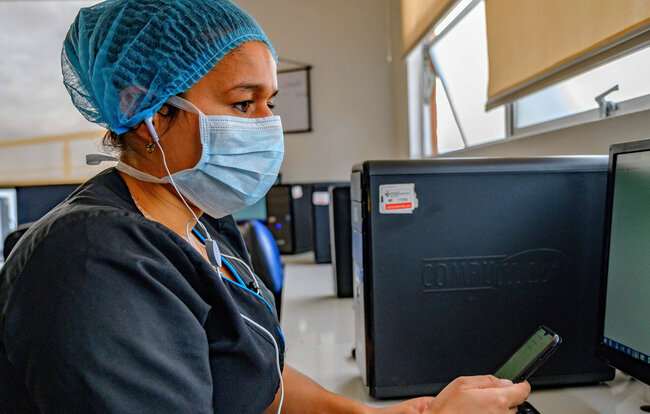
Created by PAHO and the IDB, the tool is aimed at institutions wishing to immediately provide remote health care services, and those which want to self-assess to redefine priorities over the new coronavirus
Washington, DC, 8 September 2020 (PAHO)- During the COVID-19 pandemic, when most in-person health consultations have been postponed, telemedicine is once again coming forward as a way to maintain contact between patients and doctors by minimizing the risk of transmission of the novel coronavirus, and ensuring the continuity of consultation and treatment for those in need.
In order to help interested health institutions assess their maturity level before implementing telemedicine services, the Pan American Health Organization (PAHO) and the Inter-American Development Bank (IDB) created a tool they made available in Latin America and the Caribbean, in collaboration with other institutions and experts in the region and Spain.
“Telemedicine is key to bringing care to places where health services do not arrive, and today it is a safe and effective way to evaluate suspected cases of COVID-19 and other diseases until services return to face-to-face mode,” said Sebastián García Saiso, director of PAHO’s Department of Evidence and Intelligence for Health Action. “Measuring internal capabilities is the first step in starting to implement telemedicine services, and the tool we developed can be a guide to moving forward on that path.”
The tool characterizes from 1 to 4 the maturity level of institutions to introduce medical care at a distance. Level 1 is when there is no telemedicine initiative and level 4 is when everything is ready to operate with full capacity in telemedicine services. In between these extremes are levels 2 – when there is progress, but the institution is still far from being able to implement services – and 3 – when good progress exists, and some telemedicine services could begin to be implemented.
In addition, the tool facilitates the identification of potential gaps or areas that require attention and technical support from experts, and presents an opportunity for those institutions wishing to self-assess to redefine priorities in the face of the pandemic.
The tool consists of a series of questions organized into six categories: organizational preparation, processes, digital environment, human resources, regulatory aspects, and specialized knowledge. Answers to these questions based on maturity level will allow analysis of the results by multidisciplinary teams of specialists and define the steps to follow.
Telemedicine is not new and many countries in the region and the world already have initiatives. Among the most common are tele-radiology, tele-pathology, tele-dermatology, tele-cardiology and tele-psychiatry. However, the pandemic has led to an acceleration in the need to implement those virtual services that do not always have the laws and infrastructure necessary for their proper implementation. And that’s why the tool developed by PAHO and the IDB is key to making processes cost-effective, safe and patient-focused.
The development of this tool, which is already being used also in accreditation processes in some countries of the region, is part of the support for pandemic response operations for digital health provided by the Pan American Health Organization and the Inter-American Development Bank. It is based on the models that different health institutions with different degrees of complexity have implemented in several countries around the world.

